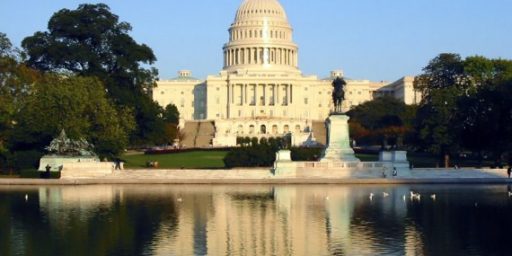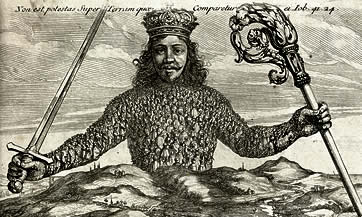How Should We Be Handling Air Security?
In a recent post James returned to a subject he’s mentioned frequently, his dissatisfaction with the security measures we’ve got in place for commercial air passenger security:
Presuming that Osama is still alive and the tape is genuine, it’s quite interesting that he’s now reduced to bragging about horribly botched operations to bolster his credibility. It would be funnier, of course, if we weren’t massively overreacting to the plot and further snarling our transportation system and curtailing the liberty of our citizens.
and I’ve observed substantial dissatisfaction with our current measures from the OTB commentariat.
Partially in reaction to James’s observation, I’ve posted a short history of air hijacking over at The Glittering Eye. I conclude that post with an attempt at soliciting the opinions of readers on the subject. Is our current approach too hot, too cold, just right? Should we be doing nothing whatever? What should we be doing?






This is the least difficult question in the entire realm of national security and public policy; the answer is profile, profile, profile.
You know how only Nixon could go to China? Well maybe Obama is the only president who could tell the ACLU and CAIR to STFU so that we can focus our transportation safety apparatus on effectively screening young Muslim and/or Arab males. You then hire El Al to come over and teach their techniques (which have, if memory serves, a 100% success rate) to our TSA folks. And if our current corps of airport flunkies are too stupid or lazy to effectively implement those techniques (which they almost certainly are), you send them out to work on the census and replace them with some of those folks with college and graduate degrees who are working as grocery baggers that the mainstream media has been telling us about.
By doing this, Obama would score massive political points across the spectrum AND enhance national security. And if the terrorists adapt and start recruiting folks who look like Donny Osmond? Well, if that was an option, why haven’t then done it yet (John Walker Lindh excepted).
Next question.
I don’t know if leaving security to the airlines are a good thing. You have security for each wing of an airport that provides one choke point. Leaving it up to the airlines, you would have to reconfigure many airports and you won’t know who is who with many choke points. The other problem is airlines always have problems with being in the black. They would charge each passenger a security charge, which I don’t have a problem with, however, it all adds up with bags and every other charge they are doing. And finally, intelligence information would have to be broken down for each airline.
On another note, intelligence is the utmost importance along with all the no fly lists to all airports and TSA. All airports should have the best security as possible, but with humans, there are mistakes. (my mind will not disseminate information as the same as yours) I don’t mind paying a fee to get the best machines in place. There should be no arguments on any profiling. It should also not be surprising that terrorists will do anything to achieve their objective. The underwear bomber was not surprising. Using women and children will not be surprising and the odd things that they will do to achieve their objective.
ABC news (Brian Ross, I believe) reported that several potential terrorists on no fly lists were “turned away” (his words) at various airports. Now, I don’t know what “turned away” means. If someone is “turned away” that was on the list wouldn’t you think that that person should be taken aside and be thoroughly searched anyway? And if caught with something, that is one more person to put in jail and one less to terrorize. And in this case we are dealing with different airports, different security, and different people. While I may talk harshly, I don’t think anyone on a no fly list should be treated lightly.
One other thing. It should be instructed by the pilot or flight attendants that we greet our passengers in front of us, in back of us, and beside us. Know your neighbor.
The el al approach wouldn’t work because the time per passenger to screen by el al times number of passengers in US divide by 2000 (number of hours in 50 weeks of 40 hours) would mean hiring more people than the US military has.
And while passengers have proven our most reliable security means (maybe the delays makes them feisty) they can probably take out any hijacking with their current briefcases and pencils.
The current big threat seems to be explosives. The current screening method seems to be of little effect against them.
We have scanners that are good enough. The privacy concerns could be handled by projecting non-flesh onto a generic model (e.g. Showing bomb materials on a anatomically smooth crotch with out showing if they are on a boy or girl). Also, sniffers should be useful for detecting the presence of explosives.
The trick to all of this is not so much the technology (most is off the shelf), but the implementation.
Imagine a combination metal detector, body scanner and explosive sniffer done as a large phone booth with dual doors and interlocks that don’t let you enter until previous person exits and you don’t exit until the scans and your ticket barcode and ID has been read. Everything could be done automatically. No human involved unless something suspicious found. Design the scanning compartment modularly so new scanning methods can be added or substituted. Then put as many machines as needed in parallel to match passenger demand worse case (e.g. Christmas rush). In normal times people would each be stopped for a few seconds for the scan and that’s it. No hours waiting to be scanned. Higher up front cost for the machine, but lower operating cost because more is automated.
Now add in profiling, facial recognition scanning, no fly and the el al screening for those who fit the profile, trigger a list (by name or facial reecognition) or who ping the scanners. For those frequent fliers who ping the list or profile, let them get more extensive background check and retinal scan to pass quickly.
Let me suggest one simple change that would simplify security and enhance passenger comfort: Rationalize the list of prohibited items. Bombs are dangerous, nail clippers (I think they may have removed this from the list anyway) are not. Nonetheless all sorts of ordinary personal items you might stash in your carry-on are not really dangerous. Hell, after 9/11 even if the bad guys have box cutters (which probably should be prohibited) the passengers could probably overwhelm them pretty quickly. The ban on darn near anything with a point or sharp edge does not enhance security, annoys passengers both at home while packing and at the airport in line, and diverts an enormous amount of effort away from actual dangers.
” You then hire El Al to come over and teach their techniques (which have, if memory serves, a 100% success rate) to our TSA folks.”
Estimates at costs for an El Al type program have run in the $60 billion-$100 billion per year from what I have seen. That would include retrofitting our airports and airplanes and subsidizing the airlines. If anyone has a better estimate, please post.
Steve
Perfect security is impossible, but TSA and seemingly most efforts today are meant to provide the illusion of security rather than actual security. So much money spent with no appreciable improvement in actual security, but a great deal of annoyance and cost to passengers.
Profiling would indeed work really well. Too bad about that darn Constitution.
Oh yeah, we only care about that doc if the “other side” is violating it …
To Franklin @10:45:
As between you and Richard Posner for Constitutional analysis, I’m going with Posner. From the Wikipedia (noted bastion of right wing propaganda) entry for “The Constitution is not a suicide pact“: